An artisanal loaf of No Knead Sourdough Bread that takes almost no skill and minimal amount of hands-on time. If you love making sourdough breads, this is one you absolutely want to try! All you need for this recipe is two ingredients -- a quality sourdough starter and flour. The bread is crusty with a tender, airy crumb and a delicious flavor.
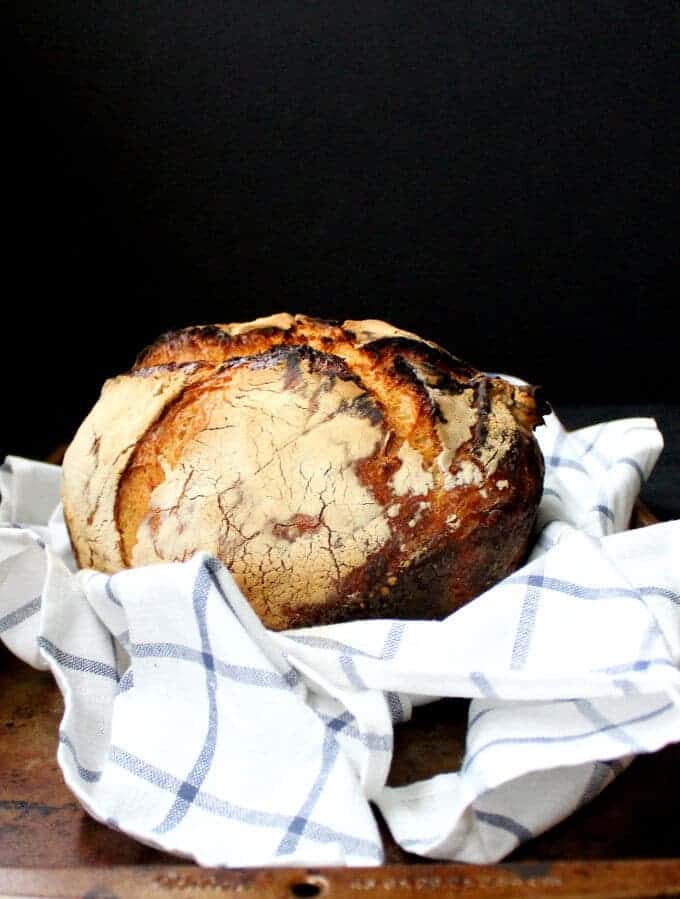
If making bread seems like a lot of work to you, I have for you today the perfect solution: my No Knead Sourdough Bread.
This is really one of my favorite bread recipes, and one everyone at home loves, including my 9-year-old, Jay. He loves eating it fresh and once it's a day old, I toast it up for him and he loves it even more. Because with a dab of vegan butter, this bread is heaven itself.
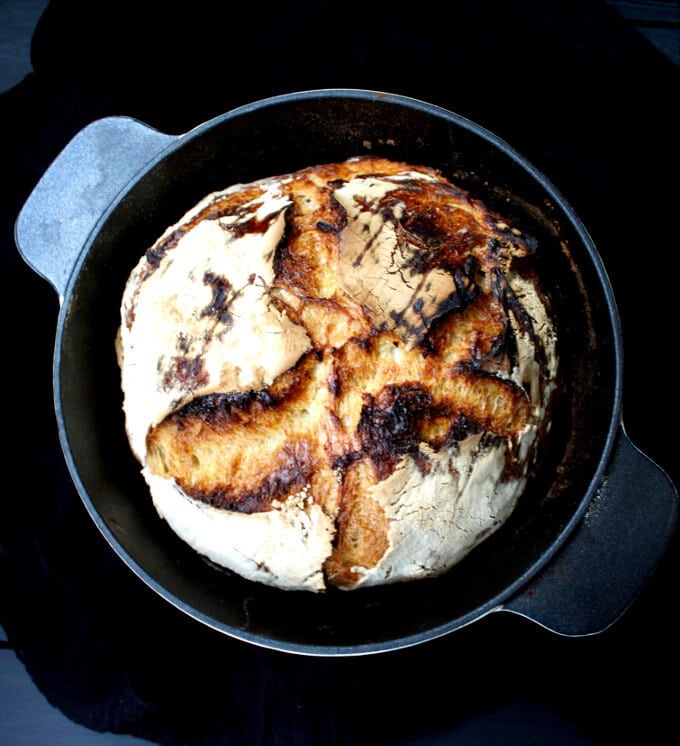
I started out with a recipe from Sam Sifton, but over the weeks I've tried different versions of it, including a part whole-wheat one that is ridiculously good, although not as airy as the version made entirely with white bread flour. It does pack in a ton of flavor, though. You can rest easy even if you make your bread with all white flour because the probiotic microflora in the sourdough slow down the rate at which glucose is released into the blood-stream, making sourdough bread -- yeah even white sourdough bread -- rank lower on the glycemic index.
The best part about making this bread is, I don't even need to refer back to the recipe. The ingredients couldn't be simpler or more basic and therefore easy to remember.
Ingredients for no-knead sourdough bread:
- Sourdough starter (here's the recipe, if you don't already have one. My starter uses ¾th cup of water for each cup of flour).
- Flour
- Salt and water
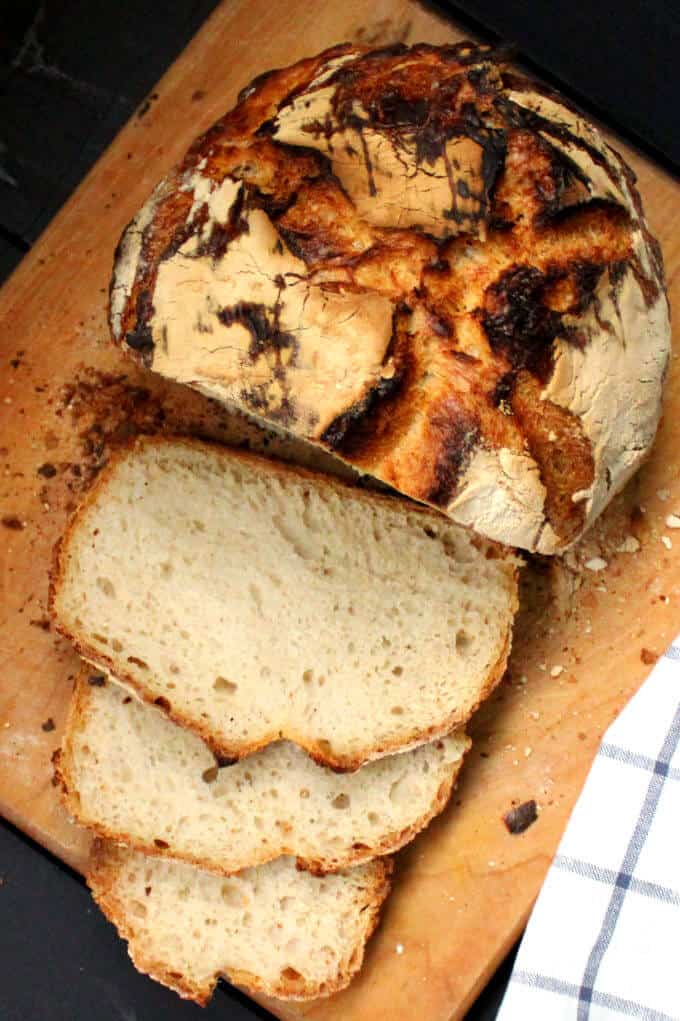
The only real work is mixing up the ingredients, but you can do it all in one bowl and set it aside to rise. Couldn't be easier. You do need some time for the sourdough to do its magic, but it's all hands-off time and some things are worth waiting for, aren't they?
The dough needs two rises. One is a longer, overnight rise, and the second is a shorter, two-hour rise. You will need a dutch oven or a heavy, oven-safe pot with a lid to bake the bread. My dutch oven is not enameled on the inside, but it works just great. You will also need some parchment paper or a kitchen towel for the second rise, with parchment a much better option.
I won't keep you waiting any longer for the recipe, but I hope you will try this loaf. If you do, I guarantee you'll love it. Be sure, as always, to follow instructions precisely. I am not a stickler for following recipe instructions, and I don't ask that you do that with mine except when you're baking.
Here's the recipe. Happy baking -- and breaking -- some delicious No Knead Sourdough Bread!
Looking for more sourdough and bread recipes:
- The Best Sourdough Sandwich Bread
- Vegan Sourdough Challah
- Vegan Olive Oil Brioche
- Crusty French Bread
- No Knead Whole Wheat Sandwich Bread
- Bread Machine Sourdough Bread
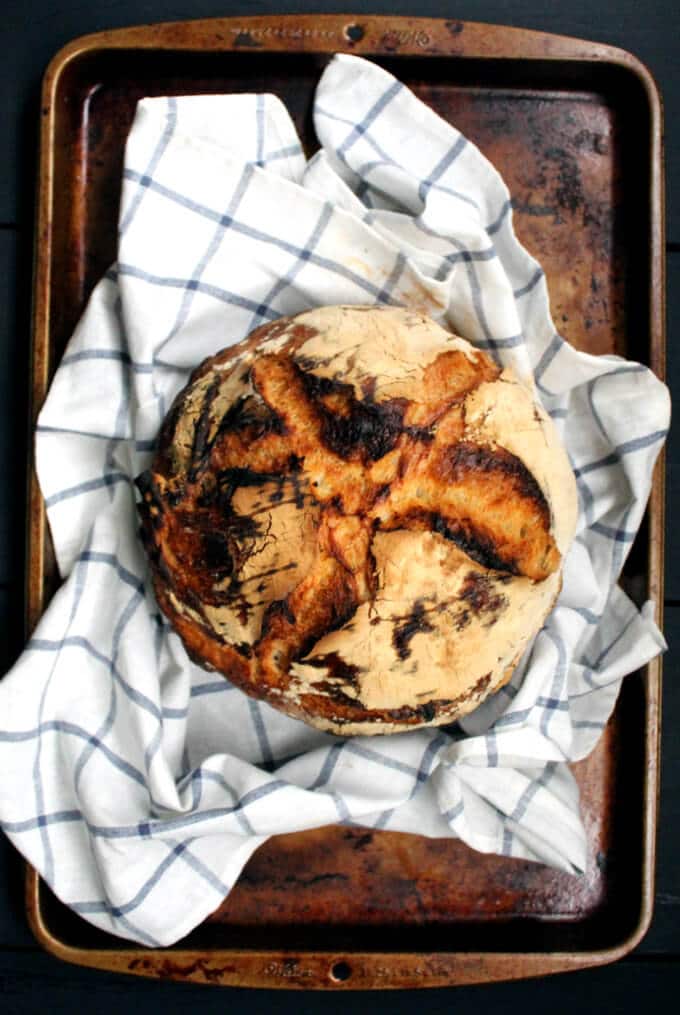
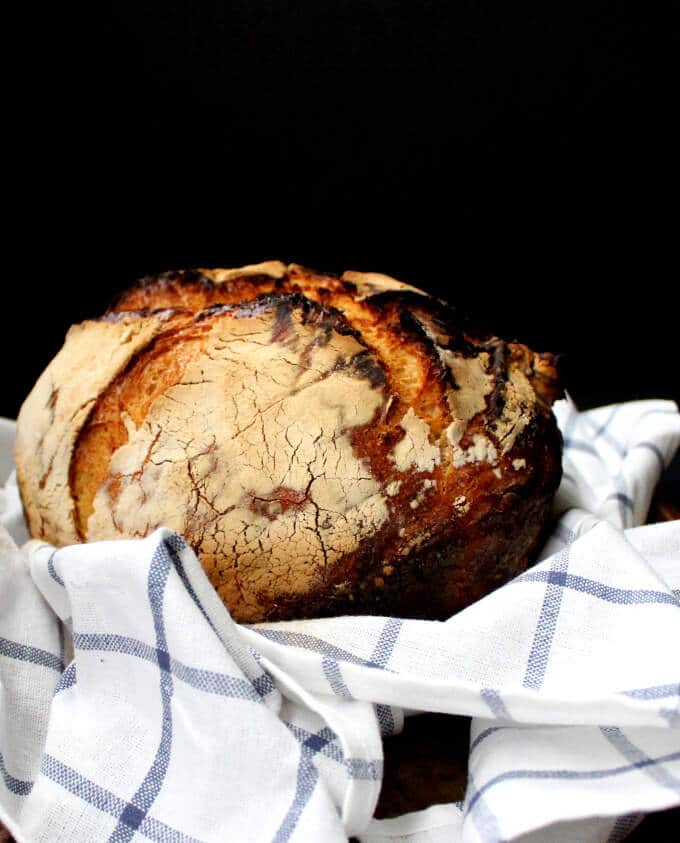
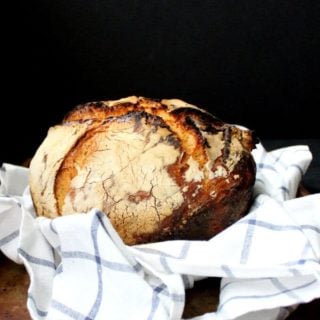
No Knead Sourdough Bread
Ingredients
- ¾ cup sourdough starter (unfed is fine, but it should have been fed at least within a week of baking the bread)
- 1 ¼ cups water (use distilled or non-chlorinated water for bread, especially sourdough breads)
- 3 ½ cups bread flour (can replace 1 cup of the bread flour with whole wheat flour. The bread will be less airy but still delicious)
- 1 teaspoon sea salt or kosher salt
Instructions
- In a large bowl, mix the sourdough starter with the water, then add the flour and salt and mix until a consistent but sticky dough forms. You can do this by hand or in your stand mixer.
- Cover the bowl with cling wrap and let the dough rise overnight or 8-10 hours.
- Turn the risen dough onto the kitchen counter and form it into a ball as best as you can. If the dough is hard to handle, flour your hands but resist the temptation to add more flour. You want a dough with higher hydration or water content for a light, airy loaf. Adding too much flour will make your bread dense. Even if your dough doesn't form into a perfect loaf, it will shape up nicely during baking in the dutch oven.
- Prepare a sheet of parchment paper by sprinkling liberally with flour. If you don't have parchment, you can use a kitchen towel sprinkled with flour, but keep in mind that there is a much higher chance of your dough deflating when it rises on a kitchen towel because it will more likely stick to the towel. Place the parchment paper or kitchen towel on a baking sheet.
- Transfer the dough onto the parchment paper or kitchen towel, seam side down. Cover (I use the bowl I mixed the dough in), and let it rise another two hours.
- About half an hour before your bread is done rising for the second time, preheat the oven to 500 degrees. Place a heavy cast-iron or other oven-safe pot in the oven with the lid on. (I use a 3.2 quart dutch oven that is not enameled on the inside. Enameled is even better.)
- Once the dough has risen, carefully remove your heated pot from the oven. Quickly, in a smooth motion, turn the dough into the pot so that the seam side now faces up. A parchment paper makes this much easier because the dough slides off more smoothly. Be very careful doing all this because the pot is very hot. If you find turning the bread into the dutch oven difficult to do without deflating it, you can just transfer the bread into the dutch oven with the parchment paper (don't do this if you used a kitchen towel).
- Put the lid back on the pot and bake for 30 minutes. Take off the lid and continue baking the bread for another 20 minutes. The bread will split at the top and char a little, which I love because the charring adds even more flavor.
- Once the loaf is baked, remove to a rack and let it cool about half an hour before carefully removing it from the pot. Let the loaf continue cooling on a rack. Slice and serve, or tear it apart with your bare hands (which you just might want to do because who has time for niceties when there's a delicious loaf of bread to be eaten 😉 ).

Rosemary Moreland
500 degrees? Is that Fahrenheit. Is seems a very high temperature
Vaishali
You need a high temperature for the oven spring.
Janice
OMG, my first loaf and so easy! It worked! The crust is like a bakery bread. I'll make it again. Thanks
Vaishali
Awesome! It’s my favorite bread to make and eat!
Greg
If you eat sourdough regularly your taste buds get used to the tangy flavour. Just an idea.
Cierra
Hi! I was wondering if I could leave the dough to rise longer than 10 hours for the first round?
Natalie
I left mine for almost 12 hours and it was fine.